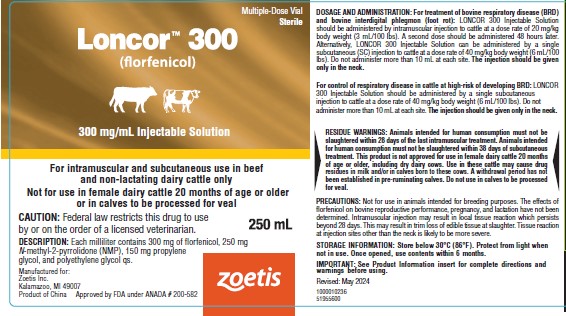LONCOR 300- florfenicol injection, solution
Loncor 300 by
Drug Labeling and Warnings
Loncor 300 by is a Animal medication manufactured, distributed, or labeled by Zoetis Inc.. Drug facts, warnings, and ingredients follow.
Drug Details [pdf]
-
SPL UNCLASSIFIED SECTION
Loncor™ 300
(florfenicol)
300 mg/mL Injectable SolutionFor intramuscular and subcutaneous use in beef and non-lactating dairy cattle only
Not for use in female dairy cattle 20 months of age or older or in calves to be processed for veal
CAUTION
Federal law restricts this drug to use by or on the order of a licensed veterinarian.
-
DESCRIPTION
LONCOR 300 Injectable Solution is a solution of the synthetic antibiotic florfenicol. Each milliliter of sterile LONCOR 300 contains 300 mg of florfenicol, 250 mg N-methyl-2-pyrrolidone (NMP), 150 mg propylene glycol, and polyethylene glycol qs. The chemical name for florfenicol is 2,2-Dichloro-N-[1-(fluoromethyl)-2-hydroxy-2-[4-(methylsulfonyl)phenyl]ethyl]acetamide.
-
INDICATIONS
LONCOR 300 is indicated for treatment of bovine respiratory disease (BRD) associated with Mannheimia haemolytica, Pasteurella multocida, and Histophilus somni, and for the treatment of bovine interdigital phlegmon (foot rot, acute interdigital necrobacillosis, infectious pododermatitis) associated with Fusobacterium necrophorum and Bacteroides melaninogenicus. Also, it is indicated for the control of respiratory disease in cattle at high risk of developing BRD associated with Mannheimia haemolytica, Pasteurella multocida, and Histophilus somni.
-
DOSAGE AND ADMINISTRATION
For treatment of bovine respiratory disease (BRD) and bovine interdigital phlegmon (foot rot): LONCOR 300 should be administered by intramuscular injection to cattle at a dose rate of 20 mg/kg body weight (3 mL/100 lbs). A second dose should be administered 48 hours later. Alternatively, LONCOR 300 can be administered by a single subcutaneous (SC) injection to cattle at a dose rate of 40 mg/kg body weight (6 mL/100 lbs). Do not administer more than 10 mL at each site. The injection should be given only in the neck.
NOTE: Intramuscular injection may result in local tissue reaction which persists beyond 28 days. This may result in trim loss of edible tissue at slaughter. Tissue reaction at injection sites other than the neck is likely to be more severe.
For control of respiratory disease in cattle at high risk of developing BRD: LONCOR 300 should be administered by a single subcutaneous injection to cattle at a dose rate of 40 mg/kg body weight (6 mL/100 lbs). Do not administer more than 10 mL at each site. The injection should be given only in the neck.
LONCOR 300 DOSAGE GUIDE ANIMAL
WEIGHT
(lbs)IM
LONCOR 300
DOSAGE
3.0 mL/100 lb
Body Weight
(mL)SC LONCOR 300
DOSAGE
6.0 mL/100 lb
Body Weight
(mL)100
3.0
6.0
200
6.0
12.0
300
9.0
18.0
400
12.0
24.0
500
15.0
30.0
600
18.0
36.0
700
21.0
42.0
800
24.0
48.0
900
27.0
54.0
1000
30.0
60.0
Clinical improvement should be evident in most treated subjects within 24 hours of initiation of treatment. If a positive response is not noted within 72 hours of initiation of treatment, the diagnosis should be re-evaluated.
RECOMMENDED INJECTION LOCATION

Do not inject more than 10 mL per injection site.
- CONTRAINDICATIONS
-
USER SAFETY WARNINGS: NOT FOR HUMAN USE. KEEP OUT OF REACH OF CHILDREN.
This product contains materials that can be irritating to skin and eyes. Avoid direct contact with skin, eyes, and clothing. In case of accidental eye exposure, flush with water for 15 minutes. In case of accidental skin exposure, wash with soap and water. Remove contaminated clothing. Consult a physician if irritation persists. Accidental injection of this product may cause local irritation. Consult a physician immediately. Reproductive and developmental toxicities have been reported in laboratory animals following high, repeated exposures to N-methyl-2-pyrrolidone (NMP). Pregnant women should wear gloves and exercise caution or avoid handling this product. The Safety Data Sheet (SDS) contains more detailed occupational safety information.
- CONTACT INFORMATION
-
PRECAUTIONS
Not for use in animals intended for breeding purposes. The effects of florfenicol on bovine reproductive performance, pregnancy, and lactation have not been determined. Toxicity studies in dogs, rats, and mice have associated the use of florfenicol with testicular degeneration and atrophy. Intramuscular injection may result in local tissue reaction which persists beyond 28 days. This may result in trim loss of edible tissue at slaughter. Tissue reaction at injection sites other than the neck is likely to be more severe.
-
RESIDUE WARNINGS
Animals intended for human consumption must not be slaughtered within 28 days of the last intramuscular treatment. Animals intended for human consumption must not be slaughtered within 38 days of subcutaneous treatment. This product is not approved for use in female dairy cattle 20 months of age or older, including dry dairy cows. Use in these cattle may cause drug residues in milk and/or in calves born to these cows. A withdrawal period has not been established in pre-ruminating calves. Do not use in calves to be processed for veal.
- ADVERSE REACTIONS
-
CLINICAL PHARMACOLOGY
The pharmacokinetic disposition of florfenicol was evaluated in feeder calves following single intramuscular (IM) administration at the recommended dose of 20 mg/kg body weight. Florfenicol was also administered intravenously (IV) to the same cattle in order to calculate the volume of distribution, clearance, and percent bioavailability1 (Table 1).
TABLE 1. Pharmacokinetic Parameter Values for Florfenicol Following IM Administration of 20 mg/kg Body Weight to Feeder Calves (n=10). * harmonic mean ** mean value *** following IV administration Cmax Maximum serum concentration Tmax Time at which Cmax is observed T 1/2 Biological half-life AUC Area under the curve Vdss Volume of distribution at steady state Clt Total body clearance Parameter
Median
Range
Cmax (μg/mL)
3.07*
1.43 - 5.60
Tmax (hr)
3.33
0.75 - 8.00
T 1/2 (hr)
18.3**
8.30 - 44.0
AUC (μgmin/mL)
4242
3200 - 6250
Bioavailability (%)
78.5
59.3 - 106
Vdss (L/kg)***
0.77
0.68 - 0.85
Clt (mL/min/kg)***
3.75
3.17 - 4.31
Florfenicol was detectable in the serum of most animals through 60 hours after intramuscular administration with a mean concentration of 0.19 µg/mL. The protein binding of florfenicol was 12.7%, 13.2%, and 18.3% at serum concentrations of 0.5, 3.0, and 16.0 µg/mL, respectively.
-
MICROBIOLOGY
Florfenicol is a synthetic, broad-spectrum antibiotic active against many Gram-negative and Gram-positive bacteria isolated from domestic animals. It acts by binding to the 50S ribosomal subunit and inhibiting bacterial protein synthesis. Florfenicol is generally considered a bacteriostatic drug, but exhibits bactericidal activity against certain bacterial species. In vitro studies demonstrate that florfenicol is active against the bovine respiratory disease (BRD) pathogens Mannheimia haemolytica, Pasteurella multocida, and Histophilus somni, and that florfenicol exhibits bactericidal activity against strains of M. haemolytica and H. somni. Clinical studies confirm the efficacy of florfenicol against BRD as well as against commonly isolated bacterial pathogens in bovine interdigital phlegmon including Fusobacterium necrophorum and Bacteroides melaninogenicus.
The minimum inhibitory concentrations (MICs) of florfenicol for BRD organisms were determined using isolates obtained from natural infections from 1990 to 1993. The MICs for interdigital phlegmon organisms were determined using isolates obtained from natural infections from 1973 to 1997 (Table 2).
TABLE 2. Florfenicol Minimum Inhibitory Concentration (MIC) Values* of Indicated Pathogens Isolated From Natural Infections of Cattle. * The correlation between the in vitro susceptibility data and clinical effectiveness is unknown. ** The lowest MIC to encompass 50% and 90% of the most susceptible isolates, respectively. Indicated pathogens
Year of
isolationIsolate
NumbersMIC50**
(μg/mL)MIC90**
(μg/mL)Mannheimia haemolytica
1990 to 1993
398
0.5
1
Pasteurella multocida
1990 to 1993
350
0.5
0.5
Histophilus somni
1990 to 1993
66
0.25
0.5
Fusobacterium necrophorum
1973 to 1997
33
0.25
0.25
Bacteroides melaninogenicus
1973 to 1997
20
0.25
0.25
-
ANIMAL SAFETY
A 10X safety study was conducted in feeder calves. Two intramuscular injections of 200 mg/kg were administered at a 48-hour interval. The calves were monitored for 14 days after the second dose. Marked anorexia, decreased water consumption, decreased body weight, and increased serum enzymes were observed following dose administration. These effects resolved by the end of the study.
A 1X, 3X, and 5X (20, 60, and 100 mg/kg) safety study was conducted in feeder calves for 3X the duration of treatment (6 injections at 48-hour intervals). Slight decrease in feed and water consumption was observed in the 1X dose group. Decreased feed and water consumption, body weight, urine pH, and increased serum enzymes, were observed in the 3X and 5X dose groups. Depression, soft stool consistency, and dehydration were also observed in some animals (most frequently at the 3X and 5X dose levels), primarily near the end of dosing.
A 43-day controlled study was conducted in healthy cattle to evaluate effects of florfenicol administered at the recommended dose on feed consumption. Although a transient decrease in feed consumption was observed, florfenicol administration had no long-term effect on body weight, rate of gain, or feed consumption.
- STORAGE INFORMATION
- HOW SUPPLIED
- REFERENCE
- SPL UNCLASSIFIED SECTION
- Principal Display Panel
-
INGREDIENTS AND APPEARANCE
LONCOR 300
florfenicol injection, solutionProduct Information Product Type PRESCRIPTION ANIMAL DRUG Item Code (Source) NDC: 54771-7318 Route of Administration INTRAMUSCULAR, SUBCUTANEOUS Active Ingredient/Active Moiety Ingredient Name Basis of Strength Strength FLORFENICOL (UNII: 9J97307Y1H) (FLORFENICOL - UNII:9J97307Y1H) FLORFENICOL 300 mg in 1 mL Packaging # Item Code Package Description Marketing Start Date Marketing End Date 1 NDC: 54771-7318-1 250 mL in 1 VIAL 2 NDC: 54771-7318-2 500 mL in 1 VIAL Marketing Information Marketing Category Application Number or Monograph Citation Marketing Start Date Marketing End Date ANADA ANADA200582 09/30/2024 Labeler - Zoetis Inc. (828851555)
© 2025 FDA.report
This site is not affiliated with or endorsed by the FDA.
